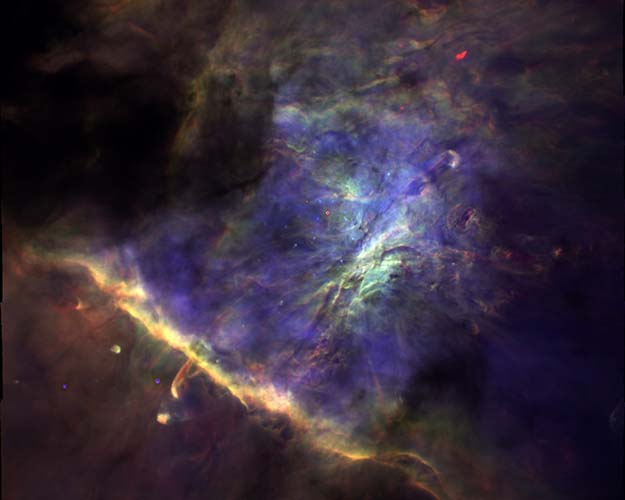Astronomers map new emission line to trace most common molecule in the Universe
Molecular hydrogen (H2) makes up 99% of the cold dense gas in galaxies. So mapping where stars are born basically means measuring H2, which lacks a strong characteristic signature at low temperatures. Astronomers from SRON Netherlands Institute for Space Research and the University of Groningen have now mapped an emission signal from the trace molecule hydrogen fluoride (HF), in a place where the standard trace molecule carbon monoxide is absent. They are the first to produce a map of HF for a region in space, creating a new tool to indirectly map H2. Publication in Astronomy & Astrophysics.

All across galaxies in our Universe, stars are dying and forming. And while our life on Earth is based on a rich jumble of various elements and molecules, the cold dense gas out of which stars form is pretty monotonous with 99% molecular hydrogen (H2). So if you want to map where stars are born, you'd better have a good grasp on how to detect H2. Unfortunately, this material is hard to observe due to a lack of a strong characteristic signal at low temperatures—unlike its atomic cousin (H) which emits radio waves at an easily distinguishable wavelength of 21 cm. Astronomers from SRON Netherlands Institute for Space Research and the University of Groningen have now discovered a new tool to indirectly measure H2, by mapping hydrogen fluoride (HF) and linking its abundance to that of H2.
Hydrogen fluoride
The new tool comes in handy when other tools fail, for example in the Orion Bar, in between regions around the Orion Trapezium stars and the Orion Molecular Cloud. In these areas carbon is ionized, meaning that carbon monoxide (CO)—usually a reliable trace molecule to find H2—can't work as a tracer in this case. Floris van der Tak (SRON/RuG) and his team were surprised to find a characteristic HF signal in data from the Herschel telescope coming from the Orion Bar, as astronomers have previously only detected hydrogen fluoride as a silhouette: HF absorbing other radiation. HF and H2 abundance can be linked because HF is produced in a chemical reaction where H2 reacts with atomic fluorine (F) to form HF and atomic hydrogen (H). Without H2 there is no HF.
Collisions
The team, led by SRON PhD student Ümit Kavak, used their map of HF to examine a few mechanisms through which it could emit its signal. Collisions of HF molecules with electrons and molecular hydrogen turns out to be the main mechanism. The collisions excite the HF molecules to a higher energy state, after which they drop to their ground state while emitting infrared light at a characteristic wavelength of 1.2 THz.
| Last modified: | 30 April 2020 4.00 p.m. |
More news
-
03 April 2025
IMChip and MimeCure in top 10 of the national Academic Startup Competition
Prof. Tamalika Banerjee’s startup IMChip and Prof. Erik Frijlink and Dr. Luke van der Koog’s startup MimeCure have made it into the top 10 of the national Academic Startup Competition.
-
01 April 2025
NSC’s electoral reform plan may have unwanted consequences
The new voting system, proposed by minister Uitermark, could jeopardize the fundamental principle of proportional representation, says Davide Grossi, Professor of Collective Decision Making and Computation at the University of Groningen
-
01 April 2025
'Diversity leads to better science'
In addition to her biological research on ageing, Hannah Dugdale also studies disparities relating to diversity in science. Thanks to the latter, she is one of the two 2024 laureates of the Athena Award, an NWO prize for successful and inspiring...
